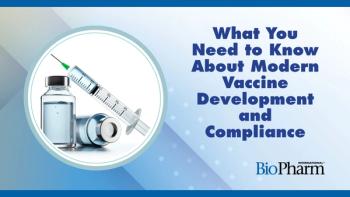
- BioPharm International-08-01-2007
- Volume 20
- Issue 8
Biotech Manufacturers Face Competition from "Similar" Follow-Ons
The main testing and regulatory provisions of the FOB legislation reflect multiple trade-offs between the demands of innovators and generics firms.
Policy makers have developed a compromise pathway for bringing biosimilar and interchangeable therapies to market. To encourage innovation while also supporting access to less costly therapies, Congressional leaders propose an extensive data exclusivity period that would delay when the FDA can approve a follow-on biologic (FOB) application. This approach recognizes that patents may not provide adequate protection for large molecules made from natural materials and unique manufacturing processes.
Jill Wechsler
ERODED PROTECTION
Biotech products regulated under the Public Health Service (PHS) Act currently do not benefit from data exclusivity provisions for drugs. At the same time, biotech innovators are less secure because the long biotech R&D process often eats up patent terms before a product gets to market.
Because biologics are made from living organisms, it is difficult to define the scope of the invention, resulting in narrow patent claims. Also, because manufacturing is an essential part of a biologic's identity, biotech patents often cover cell lines, fermentation, and purification processes, which do not provide strong obstacles to competitors.
Another key factor that would reduce protection by biotech patents is that FOBs are not identical products. The whole premise of the follow-on pathway is that the new products are similar to the innovator, but slightly different due to the nature of the production process and varying active ingredients. That will encourage generics firms to engineer production systems so that new versions of a therapy do not infringe process patents.
Thus, a revised law that permits FDA to approve FOBs based on abbreviated applications would give generics makers a strong incentive to challenge patents of most newly approved biological products. Without substantial data exclusivity, we would see "an explosion in patent challenges shortly after a new product is launched," said Henry Grabowski, economist, Duke University, at a seminar on FOBs sponsored by the American Enterprise Institute (AEI) in June. The result would be high litigation costs and additional uncertainty for innovators about their ability to recover R&D expenses.
HOW MUCH EXCLUSIVITY?
According to the Biotechnology Industry Organization (BIO), 14 years of exclusivity protection are needed to maintain incentives for innovator firms to take on the costly biotech R&D process. Grabowski explained that it costs more than $1 billion to develop a new biotech therapy, including the cost of capital and R&D failures; actual out-of-pocket cost runs over $500 million. This means that the "breakeven lifetime" for a biologic—the time needed to recover R&D costs and earn a risk-adjusted return on capital—runs 13 to 16 years and is needed to attract venture capital firms and other investors.
Although one House bill proposed 14 years of exclusivity, the FOB measure sponsored by Rep. Henry Waxman (D-CA) ignored the issue. This prompted some policy makers to suggest splitting the difference with a seven-year exclusivity period. That would be similar to the exclusivity provided orphan drugs, which has encouraged development of many treatments for rare diseases.
Alternatively, the Hatch-Waxman Act of 1984 sets a floor with five years exclusivity for conventional new drugs; that provides some protection from generic competition for those drugs that have little or no remaining patent protection at the time of launch. At the other end of the spectrum is the 10+1 years exclusivity for drugs and biologics in the EU. This longer data exclusivity period in Europe compared to the US is warranted, said Bruce Downey, chairman of Barr Laboratories, at the AEI seminar, because price controls make it harder for manufacturers to recoup R&D investment. And patents expire earlier in Europe, he noted, because they don't become mired in lengthy litigation.
NO EVERGREENING
Generics makers, not surprisingly, blasted the 12-year exclusivity period offered in the Senate compromise as "unprecedented and unwarranted." Kathleen Jaeger, president of the Generic Pharmaceutical Association (GPhA), sought clearer limits on products eligible for exclusivity and language to prevent "evergreening" patent monopolies through minor product changes.
In finalizing the bill, Sen. Edward Kennedy (D-MA), chair of the Senate Health, Education, Labor and Pensions (HELP) Committee, clarified that a reference product can have only one 12-year exclusivity period. Such exclusivity starts the day FDA approves the product for market, and innovators can't add more years by developing new formulations or dosage forms, adding new indications or conducting pediatric studies. The exclusivity applies only to a biologic that is comparable to a new chemical entity for drugs, and not to a slightly different version of an existing treatment.
Kennedy touted the Senate compromise as a way to "encourage the innovation that leads to these new medical miracles," as well as to ensure that they are affordable for patients. Senators Orrin Hatch (R-UT), Mike Enzi (R-Wyo), ranking Republican on the HELP committee, and Hillary Clinton (D-NY) all signed off on the measure, making partisan changes difficult.
One reason for agreeing to 12 years exclusivity, said Clinton, is that many biotech therapies have been on the market long enough to be eligible immediately for follow-on competition. Amgen's anemia treatment Epogen (epoetin alfa), for example, was approved in the US in 1989, and other biotech therapies for multiple sclerosis, cancer, hepatitis C, and diabetes have or will soon exceed the exclusivity period.
DELICATE BALANCING ACT
The Senate bill announced in June permits generics makers to file an application for a biosimilar four years after the start of the innovator's exclusivity period, a move that triggers a multistep process designed to resolve patent issues early on. It calls for an exchange of confidential information between the follow-on firm and the innovator on manufacturing process and product characteristics to identify effective patents. It is not clear just how the system will work, and biotech firms are concerned that the follow-on firm will determine which patents can be litigated, making it harder to defend patent rights.
Congress also offers a process for developing interchangeable FOBs. But to gain approval of an FOB that pharmacists can substitute for the original product without the prescriber's okay, the follow-on maker will have to conduct clinical trials to show that the new product can be switched with the original one without any clinical differences. The legislation offers FOB sponsors a one-year data exclusivity award as an incentive to take that route.
The main testing and regulatory provisions of the FOB legislation reflect multiple trade-offs between the demands of innovators and generics firms. The measure calls for at least one or more clinical studies to assess immunogenicity of a follow-on, but gives FDA leeway to waive that requirement.
FDA may develop guidance for testing and developing FOBs, but generics firms don't have to wait for such guidance in order to move forward with testing and applications. Such guidance could indicate that existing science does not support follow-ons for a certain product class, but FDA could revise such a finding later on.
Follow-on applicants will start off by paying user fees on applications while FDA assesses the costs of running the program and recommends changes in the fee structure. Along those lines, the FDA review division that approved the innovator will assess any follow-ons—not FDA's Office of Generic Drugs. This could encourage FDA reviewers to compare proprietary brand data when evaluating an FOB, something that innovators strongly oppose.
A provision in the Senate bill calls for the government to determine how much money the healthcare system saves from allowing follow-on biologics to come to market. A lot of interest groups have predicted huge gains from FOBs, and it will be interesting to see the results.
Jill Wechsler is BioPharm International's Washington editor, Chevy Chase, MD 301.656.4634,
Articles in this issue
over 18 years ago
From the Editor: After Zhengover 18 years ago
Process Development: Think Like a Scientist—Behave Like a Businessover 18 years ago
Street Talk: Small-Cap Biopharmaceutical Stocksover 18 years ago
Drug Delivery: What The Future Holdsover 18 years ago
Final Word: The Case for Flexible Manufacturing Capacityover 18 years ago
China Today: Biopharmaceutical Exportsover 18 years ago
Patents: Patent Strategies for Biotechnology EnterprisesNewsletter
Stay at the forefront of biopharmaceutical innovation—subscribe to BioPharm International for expert insights on drug development, manufacturing, compliance, and more.





